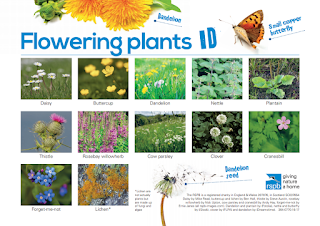Wildflower and Fungi Research
Grow Wild
- sells seed kits for people to grow wildflowers- colourful selection
- easy to grow
- sourced by UK Native Seed Hub
Wildflowers
- There are 1600 species of wildflower in Britain and Ireland- Annual - flower in first year then produce seeds for the following year
- Perennial - flower in the second year and continue after this
- Biennial - grow in first year but flower every other year
- they support insects and wildlife
- provide pollinators with food
- fruits, vegetables and nuts need insects to pollinate them
- insects keep crop pests in check
- pesticides have to be used if these insects aren't available to do the job
- used in science and medical research e.g. foxgloves are used for heart conditions
- Growing Wildflowers : sow in spring or autumn, dig soil over and remove weeds, rake soil, scatter wildflowers over soil and spread evenly (mix with sand to help know where you have planted them) rake the soil and cover seeds with 1mm of soil, water gently
- wildflowers can be planted in pots, and containers
- label pot with sowing date
- seeds germinate in a couple of weeks
- mechanical scarification allows seeds to germinate, this means the outer layer of the seed is scratched allowing water, air etc to get through
- wildflowers provide nectar and pollen for pollinators
- wildflowers need pollinators to seed
- 70% of butterfly species in decline
- moths have decreased by 30%
- 97% of meadows lost
- 7.5 million acres of wildflower habitat destroyed
- wildflower verges decreased by 20%
- native wild plants and wildlife have evolved together so are able to sustain one another
- leave a patch of lawn to get long and grow flowers for insects
- 16 million gardens in UK
Fungi
- not animals or plants, have own kingdom- can find fungi everywhere - Arctic to desert
- visible part is the fruit
- mushroom produces spores which float away and allow it to reproduce
- fine threads that make up the rest of the fungi not visible, called the mycelium, which are used by the mushroom to get food and water
- fungus grows in roots of plants or covers the roots. This allows them to get nutrients and sugars they wouldn't be able to get on their own
- 95% of plants need fungus to survive
- fungus can't make food by energy from the sun
- enzymes are created by the fungus and released by the mycelium, which breaks down organic waste and is used for growth
- only organism that can break down wood efficiently, which stops leaves and old wood building up and helps us survive
- used for medicines such as penicillin
- foods such as cheese, beer, chocolate etc use fungi
- fungi is used to make environmentally friendly leather, packaging and building materials
- live in damp areas e.g. rotting tree stumps or damp soil near living trees
- live on dead branches and in grassy fields
- there are 100,000 species of fungi
- 'the most significant virtue of mushroom cultivation is that mushrooms can perform the alchemy of transforming agricultural and other organic waste into a nutritious and marketable product'
- '90% of all plants have symbiotic relationship with fungi'
https://www.growwilduk.com/content/wildflower-gallery
https://www.growwilduk.com/content/why-fungi-matter
https://www.growwilduk.com/sites/default/files/media/Five%20ways%20fungi%20have%20shaped%20the%20world.pdf
https://www.growwilduk.com/content/why-wildflowers-matter
https://www.growwilduk.com/content/how-sow-wildflower-seeds
https://www.growwilduk.com/blog/2018/11/14/5-unexpected-ways-seeds-kickstart-growing-process
https://www.rspb.org.uk/fun-and-learning/for-families/family-wild-challenge/activities/fabulous-fungi/
https://www.rspb.org.uk/globalassets/downloads/wildchallenge/activity-sheets/770-0214-18-19-wild-challenge_fungi-finder.pdf
https://www.woodlandtrust.org.uk/visiting-woods/trees-woods-and-wildlife/plants-and-fungi/fungi/
https://www.rspb.org.uk/globalassets/downloads/discoverenjoy/families/flowering-plants-id.pdf
http://plantlife.love-wildflowers.org.uk/wildflower_garden/how_to_grow_a_wildflower_meadow
https://www.plantlife.org.uk/uk/support-us/protecting-pollinators
https://www.fungimag.com/spring-08-articles/sustainability.pdf




No comments:
Post a Comment
Note: only a member of this blog may post a comment.